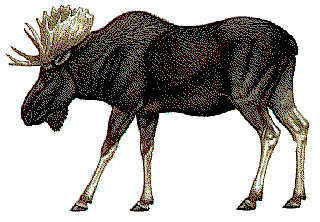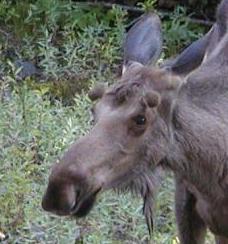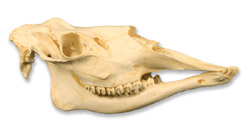 Life span: 15-25 years
Life span: 15-25 yearsMoose are large even-toed herbivorous mammals, the largest of the deer family.
Moose vary in size and shape. Their colour varies from a little brown to a dusty black depending on the season and age of the animal. Calves, in comparison, are often a light rusty colour.
Moose have long, lighter-colored legs with the front pair longer than the hind ones. Other features include a long nose, drooping lip, hump at the shoulders and small tail. The flap of skin that hangs beneath the throat is called a BELL.
Males weigh on average over 550 kg (1200 lbs) and females often more than 400 kg (900 lbs). New born calves weigh around 15 kg but quickly increase in size, around 300 or 400 pounds by its first winter. An Alaskan moose, one of the largest sub-group, discovered in 1897 holds the record for being the largest known modern deer. It was a bull standing 2.34 metres and weighed 816kg. Its RACK (or antler spread) was 199cm.
Height at the shoulders generally ranges between 6 ½-7 ½ feet (over 2 metres).
The other end of the size scale is the smaller Shiras moose, also known as the 'Wyoming' or 'Yellowstone' moose. These animals are lighter in colour around the ears and back and have smaller hooves and antlers. Unlike other subspecies they are comfortable at higher elevations.
 Only the males have antlers, massive flattened ones averaging 160cm across and 20kg in weight. These antlers have as many as 30 TINES (or spikes), the shape differing from animal to animal.
Only the males have antlers, massive flattened ones averaging 160cm across and 20kg in weight. These antlers have as many as 30 TINES (or spikes), the shape differing from animal to animal.
A young moose's first pair of antlers grow from two tiny bumps on their head that they have had from birth. A bull of about a year old can be seen on the right with the first signs of antler growth visible.
Mature males shed their antlers once a year in November/December and replace them with new larger ones in the Spring. They are formed of living tissue supplied by blood through a network of vessels covered with a soft smooth skin called VELVET. Eventually the tissue solidifies, the velvet is scraped off and the antlers become completely formed of mineralised dead matter. Their main function is for display during the mating season and dominance within the herd.
The reindeer/caribou is the only deer species in which both the male and female have antlers.

The image on the right shows a replica female moose skull. The skull length is 63cm or 24.5 inches.
A moose's teeth are specially designed for eating plant materials and for browsing on bushes and small trees. In all they have 32 teeth made up of 12 ridged molars, 12 premolars, 6 incisors and 2 canines:
| ( | I | 0 3 |
C | 0 1 |
P | 3 3 |
M | 3 3 |
= | x 2 | =32 | ) |
... or return Home.